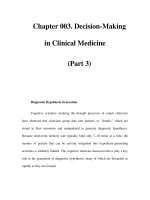Chapter 064. The Practice of Genetics in Clinical Medicine (Part 3) potx
Bạn đang xem bản rút gọn của tài liệu. Xem và tải ngay bản đầy đủ của tài liệu tại đây (36.97 KB, 5 trang )
Chapter 064. The Practice of Genetics
in Clinical Medicine
(Part 3)
Recall of family history is often inaccurate. This is especially so when the
history is remote and families become more dispersed geographically. It can be
helpful to ask patients to fill out family history forms before or after their visits, as
this provides them with an opportunity to contact relatives. Attempts should be
made to confirm the illnesses reported in the family history before making
important and, in certain circumstances, irreversible management decisions. This
process is often labor intensive and ideally involves interviews of additional
family members or reviewing medical records, autopsy reports, and death
certificates.
Although many inherited disorders will be suggested by the clustering of
relatives with the same or related conditions, it is important to note that disease
penetrance is incomplete for most multifactorial genetic disorders. As a result, the
pedigree obtained in such families may not exhibit a clear Mendelian inheritance
pattern, as not all family members carrying the disease-associated alleles will
manifest a clinical disorder.
Furthermore, genes associated with some of these disorders often exhibit
variable expression of disease. For example, the breast cancer–associated gene
BRCA1 can predispose to several different malignancies in the same family,
including cancers of the breast, ovary, and prostate (Chap. 79).
For common diseases such as breast cancer, some family members without
the disease-causing mutation may also develop breast cancer, representing another
confounding variable in the pedigree analysis.
Some of the aforementioned features of the family history are illustrated in
Fig. 64-1. In this example, the proband, a 36-year-old woman (IV-1), has a strong
history of breast and ovarian cancer on the paternal side of her family. The early
age of onset, as well as the co-occurrence of breast and ovarian cancer in this
family, suggests the possibility of an inherited mutation in BRCA1 or BRCA2. It is
unclear though—without genetic testing—whether her father inherited such a
mutation and transmitted it to her. After appropriate genetic counseling of the
proband and her family, one approach to DNA analysis in this family is to test the
cancer-affected 42-year-old living cousin for the presence of a BRCA1 or BRCA2
mutation. If a mutation is found, then it is possible to test for this particular
alteration in the proband and other family members, if they so desire. In the
example shown, if the proband's father has the BRCA1 mutation, there is a 50:50
probability that the mutation was transmitted to her, and genetic testing can be
used to establish the absence or presence of this alteration.
Figure 64-1
A 36-year-old woman (arrow) seeks consultation because of her family
history of cancer.
The patient expresses concern that the multiple cancers in her relatives
imply an inherited predisposition to develop cancer. The family history is recorded
and records of the patient's relatives confirm the reported diagnoses.
Genetic Testing for Adult-Onset Disorders
A critical first step before initiating genetic testing is to ensure that the
correct clinical diagnosis has been made, whether based on family history,
characteristic physical findings, or biochemical testing. Careful clinical assessment
can define the phenotype, thereby preventing unnecessary testing and directing
testing toward the most probable candidate genes (Fig. 64-2).
For patients identified by population-based screening (e.g., diabetes,
hypercholesterolemia), testing might involve known candidate genes, or genome-
wide linkage studies (HapMap) of the population could be used as part of a
research study to identify susceptibility alleles.
For patients with a strong family history (e.g., breast cancer,
hemochromatosis), testing often includes known candidate genes, or traditional
linkage analyses within pedigrees can identify disease-causing genes. Once
candidate genes are known, mutational analyses can be performed after pretest
genetic counseling (see below).









